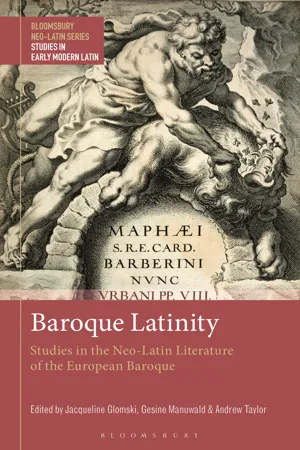
Baroque Latinity
Studies in the Neo-Latin Literature of the European Baroque
- 224 pages
- English
- ePUB (mobile friendly)
- Available on iOS & Android
Baroque Latinity
Studies in the Neo-Latin Literature of the European Baroque
About this book
This volume addresses the idea of the Baroque in European literature in Latin. With contributions by scholars from various disciplines and countries, and by looking at a range of texts from across Europe, the volume offers case studies to deepen scholarly understanding of this important literary phenomenon and inspire future research. A key aim of the volume is to address the distinctiveness of these texts by interrogating the usefulness and specificity of the term 'Baroque', especially in relation to the classical rules it transgresses to produce effects of grandeur, richness, and exuberance in a range of secular and sacred arts (e.g. music, architecture, painting), as well as various forms of literature (e.g. prose, poetry, drama). The contributors consider how and why Latin writing mutated from earlier humanist paradigms, thus exploring how ideas of 'early modern' and 'Baroque' are related, and examine the interplay of the theory and practice of the 'Baroque', including its debts to and deviations from ancient models, and its limits and limitations.
Frequently asked questions
- Essential is ideal for learners and professionals who enjoy exploring a wide range of subjects. Access the Essential Library with 800,000+ trusted titles and best-sellers across business, personal growth, and the humanities. Includes unlimited reading time and Standard Read Aloud voice.
- Complete: Perfect for advanced learners and researchers needing full, unrestricted access. Unlock 1.4M+ books across hundreds of subjects, including academic and specialized titles. The Complete Plan also includes advanced features like Premium Read Aloud and Research Assistant.
Please note we cannot support devices running on iOS 13 and Android 7 or earlier. Learn more about using the app.
Information
Table of contents
- Cover
- Half-Title Page
- Series Page
- Title Page
- Contents
- Contributors
- Preface
- Introduction
- 1 The Sixteenth Century’s Revolution in Rhetoric and its Impact on the Baroque
- 2 The Greekness of Latin Baroque: Hermogenes and Ingenuity in Julius Caesar Scaliger’s Poetices libri septem
- 3 The Triumph of the Saint: St Casimir Jagiellon and Militant Motifs in Baroque Hagiographical Poetry
- 4 Innovation and Fusion: Sarbiewski’s Theory of Baroque Literary Style
- 5 Christ’s Blood or Mary’s Milk? ‘Clarus Bonarscius’, Baroque Piety and English Protestant Outrage
- 6 Baroque Latinity and Ancient Literary Models: The Example of Claude-Barthélemy Morisot’s Peruviana (1644)
- 7 Maffeo Barberini’s Poems for the Farnese Family in Early Baroque Rome
- 8 Baroque Features in the Latin Poetry of Paul Fleming (1609–40) and Georg Gloger (1603–31)
- 9 What Makes a Neo-Latin Tragedy Baroque? The Spanish Netherlands, the Dutch Republic and Beyond
- 10 Asses at the Lyre: Latin as Musical Language in the Seventeenth Century and the Benefits of Exclusion
- 11 Latin Motet Texts in Seventeenth-Century Rome and the Exercitia spiritualia of St Ignatius of Loyola
- Index of Names
- Copyright